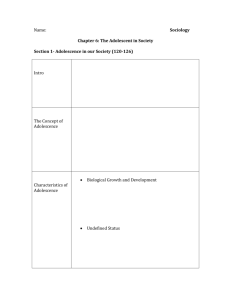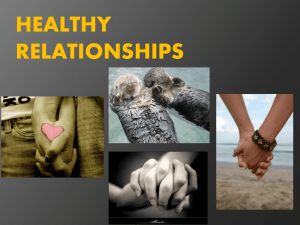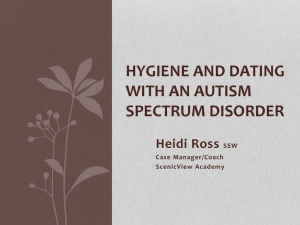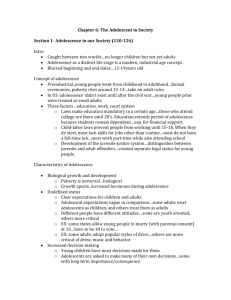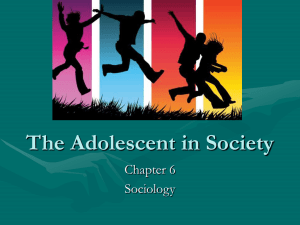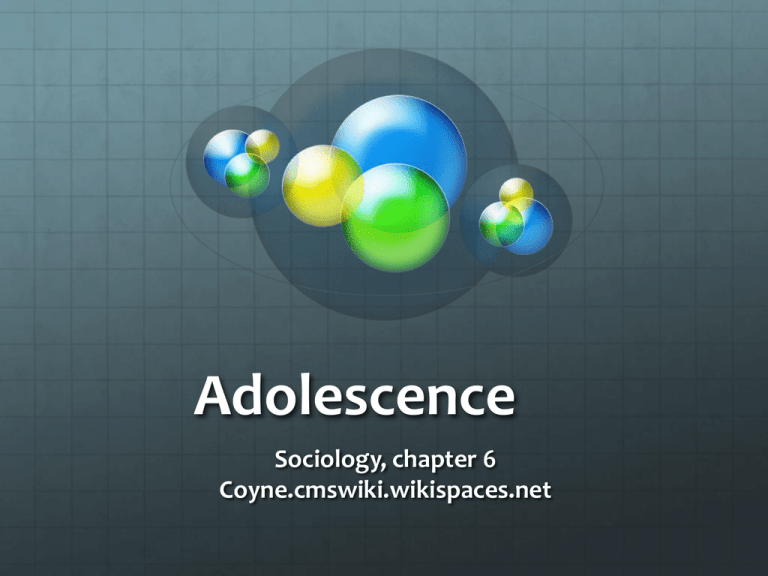
Adolescence
Sociology, chapter 6
Coyne.cmswiki.wikispaces.net
The Individual in Society
Socializing the individual
Personality as a mixture of nature and nurture
Many factors shape development of the individual:
cultural environment, heredity, parents, birth order,
primary relationships
Institutions affect development: the family, peer
group, school, mass media
Next units - different stages of life – how does the
individual develop and change
Childhood
Most values and social norms are learned during
early childhood
Adolescence is the life stage between childhood and
adulthood
The concept of adolescence is not a universal
phenomena. It is an invention of modern industrial
society. In some parts of the world it simply does not
exist.
Adolescence
Period between the normal onset of puberty and the
beginning of adulthood
Age and aging are of particular interest to
sociologists – roles change though out lifetime
Roles when young are expected to be connected to
education, middle age is connected to institutions of
marriage and family development,
Rites of passage mark movement between stages:
bar mitzvah , graduation, retirement
Age cohorts are those at common stage of life
American development
Pre-civil war no recognition of adolescence as a
distinct stage of life
Industrial revolution = development of sociology as a
field of study at same time as adolescence was
becoming a separate stage of life.
Social movements in the United States western
society give children greater legal protections and
privileges- ex. Progressive movement
Education changes
Labor law changes
Juvenile justice
Adolescence in America
Prior to 1860s
Adolescence did not exist. Children
were treated as small adults.
Education
Children stay in
school longer;
extended period
of dependence
Work
Laws restricted child
labor, also increasing
length of dependency
Courts
Juvenile-justice
system legally
distinguished between
youth and adults
Effect
Development of adolescence as a distinct life
stage between childhood and adulthood
Rites of Adolescence
Formal ceremonies -education
Religion
Demonstrations of strength or endurance, tattooing,
scarring of skin. Completing these rites of puberty
means immediate acceptance into adult society
5 Characteristics
1. Biological growth and development – puberty is a
universal characteristic because it is biological not
cultural. Body changes in brain and endocrine
system.
2. Undefined status – expectations for children and
adults are far more clearly defined. Treatment differs
by person. Age able to marry – some states 16 with
parent consent, others not until 18.
3. Increased decision making – growing sense of independence.
Classes, extra curriculars.
Team sport
White 30.8%
African American 32.3%
Hispanic 25.8%
Asian American 28.3%
Cheerleading
White 7.4%
African American 10.6%
Hispanic 6.7%
Asian American 5.1%
Academic clubs
White 25.8%
African American 20.7%
Hispanic 22.6%
Asian American 32.3%
4. Increased pressure – parents make demands, peer
pressure, job pressures, relationship pressures. Wish
to part of the in-crowd. Billions of dollars are spent
on advertising specific to this age group. Roles begin
to conflict and the need for independence presents
psychological challenges
Ex. Jobs 2000 study 44% 16-17 year olds have a job.
Gain an income, a sense of responsibility, skills like
how to manage money
Studies say those who work over 20 hours get less
sleep, lower grades, and more likely to use drugs.
5. The search for self – mature enough to
decide what want out of life. Most can sort
through their values and decide what is really
important to them. Develop own personal
norms and set priorities for their lives.
Anticipatory socialization involves learning
the rights, obligations, and expectations of a
role to prepare for assuming that role in the
future.
Dating
The meeting of people as a romantic engagement.
Found in societies that allow individuals to choose
their own marriage partners
Some cultures arranged parents are the norm as
parents negotiate a formal marriage contract
between families
Emerged only after WW I as widespread phenomena
Courtship & Dating
Dating ranges on a continuum from casual dating,
progresses to steady dating, then moves on to
engagement, and eventually to marriage.
Courtship differs in that it’s express purpose is
marriage. Not casual, roles very strictly defined. First
meet parents and ask permission to court, under
close supervision, purpose to find a spouse.
Dating develops
Rise of industrialization – men no longer on farm
where the tradition was to wait for marriage until
sufficient property to afford a wife=great age
disparities.
Urban life left adolescents with greater
independence and no expectation of future
‘property’.
Free secondary education meant a coeducational
environment to develop relationships
1920s and 30s dating culture flourishes on campuses
with greater equality for women
Early Sociologists study
Partners now selected for status characteristics
(good looks, popularity, nice clothes) rather than
traits of dependability and honesty
William Waller studied dating on Penn State campus,
fraternities and sororities. Dated persons with equal
social rank, social standing, similar looks
Rating and dating game – status attainment,
attractiveness, tend to marry people who have social
characteristics similar to their own
Why date?
Dating as form of entertainment
Form of socialization – teaches about other gender,
how to behave in social situations. Helps learn
appropriate role behaviors and to define their own
self concepts
Fulfills basic psychological needs such as
conversation, companionship and understanding
Helps individuals attain status
Allows for spouse selection in later stages
Dating patterns
Traditional dating patterns – man asks woman out. Makes
arrangements. Pays for all the expenses of the evening. Comes to
the door (no horn honking!) and meets father. RITUALIZED. Rules
were widely known. Accepting date late in the week means less
popular. LESSENS STRESS. Amish dating buggy.
Contemporary Dating patterns – no set stages for dating. Either ask
or pay. Fewer rules means more
stress .When is a given behavior
appropriate to a developing
relationship?
Music
Pop music develops largely as a result of developing
dating trauma
Learning group assignment: each learning group will
be responsible for finding a song from each of the
following eras: 1. the 1950s/early 60s, 2. the late
1960s, 3. the 1970s/80s/90s, 4. 2000 onward. Bring a
copy of the lyrics with you on Wednesday. Discussion
will describe how each lyric reflects on dating culture
and how the norms of dating in music have changed.
1950s/early 60s: It’s My Party and I’ll Cry if I Want To,
Lesley Gore
http://www.youtube.com/watch?v=XsYJyVEUaC4
Late 1960s: These Boots Are Made for Walkin’,Nancy
Sinatra
http://www.youtube.com/watch?v=SbyAZQ45uww&feat
ure=related
70s/80s/90s Jesse’s Girl, Rick Springfield
http://www.youtube.com/watch?v=qYkbTyHXwbs
2000+ Someone Like You, Adele
http://www.youtube.com/watch?v=hLQl3WQQoQ0&featur
e=related
Influence of music videos as additional elements of
storytelling with music.
http://www.youtube.com/watch?v=sOnqjkJTMaA
Challenges of
Adolescence
What are the social problems facing contemporary
teenagers? 1980s and 1990s boom in scientific research on
the adolescent stage of development
What are the causes and consequences of these problems?
Teenage sexual behavior
Teenage drug use
Teenage eating disorders
Teenage suicide
Sexual activity
Traditional American values stem from a Puritan past and
Victorian values that include strict norms against
premarital sexual activity
Some societies permit adolescents to engage in sexual
activities before marriage. The Trobrianders of the South
Pacific Ocean even encourage it as discussed in your text.
1960s and 1970s see the introduction of the birth control
pill and the sexual revolution countering the traditional
norms
Familiar aspect of American culture, children sexualized
earlier, sell products
Studies show rise in sexual activity from the 1950s to
the 1990s, slow decline after
STDs and AIDS- studies show students are aware of
risks
Birthrates among American teenagers is higher than
other industrialized nations
Early sexual behavior influenced by family income
level, parents’ marital status, religious participation,
peer pressure, self concept
Consequences
Babies born to teen mothers have lower birth raes
and are more likely to die in the first year than
mothers in 20s
Mothers and fathers are less likely to finish school or
go on to college
Lower lifetime earnings (as a result of education)
than those who delay childbearing to later in life
More learning disabilities, increased risk of becoming
teen parents themselves
Stresses of parenting, relationship to parents,
significant other, and social judgment
Drug Use
Any substance that changes mood, behavior, or
consciousness. Many forms, legal and illegal.
Drug violence and illegal activities
Since 1975 Univ. of Michigan Institute for Social
Research has conducted an annual survey of HS
seniors. 2001 49% tried Marijuana, 8% cocaine, 2%
heroin, amphetamines 16%, alcohol 80%, cigarettes
61%. Highest rates of any industrialized country
Use of drugs higher amongst hs dropouts
Influences
Having friends who use regularly
Having social and academic adjustment problems
Living in a hostile and rejecting family setting
Studies show teens recognize the risks of drug use,
but low recognition of harms of alcohol use
Eating Disorders
Eating disorders refer to a group of conditions defined by
abnormal eating habits that may involve either
insufficient or excessive food intake to the detriment of
an individual’s physical and mental health. Bulimia
nervosa, anorexia nervosa, and binge eating disorder are
the most common specific form
Eating disorders are increasing all over the world among
both men and women, there is evidence to suggest that it
is women in the Western world who are at the highest risk
of developing them and the degree of westernization
increases the risk. Nearly half of all Americans personally
know someone with an eating disorder. Highest risk
amongst teen girls.
Not all cultures regard thinness as attractive. The
people of Fiji have traditionally considered a sturdy
rounded figure as ideal.
Compliment to tell another they look as if they have
gained weight
Loss of weight seen as a sign of poor health, low
income, low fertility
21st century clash of values as tv was introduced in
1995, reshaping the body introduced as a new
concept, new signs of young girl eating disorders
Teen Suicide
Rate of suicide more than doubled last 3 decades.
Third leading cause of death 15-24, after accidents
and homicides in America.
Personal act that results from psychological factors
such as depression, sociologists interested in what
social factors influence suicide rates
Emile Durkheim classic study Suicide is still the most
comprehensive analysis, level of integration in a
group or society is key
Social integration is the degree of attachment people
have to social groups or to society as a whole
Very high level of social integration greater risks if
put the whole above own concerns. Elderly people
of the traditional Inuit society walk off into the
snowy wild to avoid being a burden on the group.
Very low level of social integration greater risk from
rapid social change, natural disasters, sudden
changes in economic conditions that loosen group
affiliations and bonds.
Predictors
Alcohol or drug use
Typically have low levels of self control and are easily
frustrated
Under the influence, teens are more likely to act on impulse
Use as a method for committing act
Triggering events – fear of punishment, rejection by
important person, family crisis
Age – increased risk with age
Sex – 3x more likely to attempt, males more likely to
succeed (pills vs. gun)
Predictors
Population density – under populated areas higher
rates, social isolation
Family relations-families marked by violence, intense
conflict, recent loss of a parent due to death or
divorce greater likelihood
Cluster effect – copycat phenomena following a
highly publicized case



